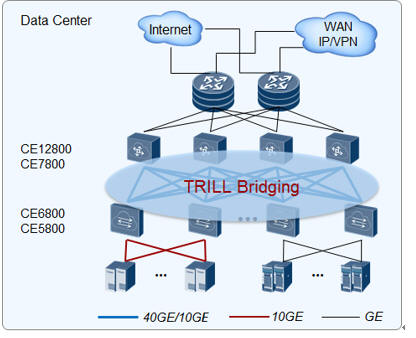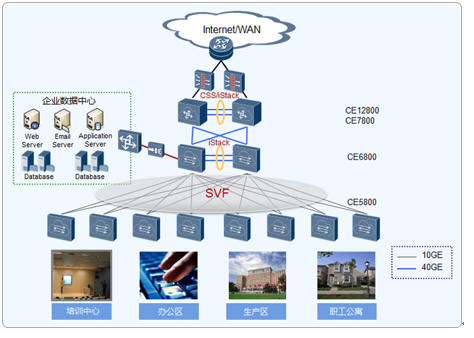Huawei CloudEngine CE7800 series switches are next-generation 40G
Ethernet switches designed for data centers and high-end campus
networks. The switches provide high-performance, high-density 40 GE
ports, and low latency. The switch hardware has an advanced
architectural design with 40 GE QSFP+ ports. Using the Huawei VRP8
software platform, CE7800 switches provide extensive data center
service features and high stacking capability. In addition, the
airflow direction (front-to-back or back-to-front) can be changed.
CE7800 switches can work with CE12800/6800/5800 switches to build an
elastic, virtualized, high-quality fabric that meets the
requirements of cloud-computing data centers.
CE7800 switches can function as core or aggregation switches on data
center networks to help enterprises and carriers build a scalable
data center network platform in the cloud computing era. They can
also be used as aggregation or core switches for enterprise campus
networks.
The CE7800 comes in one model.
| Model and appearance | Description |
|---|---|
|
|
32 x 40 GE QSFP+ ports |
| Item | CE7850-32Q-EI |
|---|---|
| Ports | 32 x 40 GE QSFP+ |
| Switching Capacity | 2.56 Tbit/s |
| Forwarding Performance | 1,440 Mpps |
| Airflow Design | Front-to-back or back-to-front |
| Device Virtualization | iStack |
| Network Virtualization | M-LAG |
| TRILL | |
| VXLAN routing and bridging | |
| EVPN | |
| VM-awareness | Agile Controller |
| Network Convergence | FCoE |
| DCBX, PFC, and ETS | |
|
Programmability |
openflow |
| ENP | |
| OPS | |
| openflow, Puppet, and Ovsdb plugins released on open source websites | |
| Linux container for open source and customization programming | |
| Traffic Analysis | NetStream |
| sFlow | |
| VLAN | Adding access, trunk, and hybrid interfaces to VLANs |
| Default VLAN | |
| QinQ | |
| MUX VLAN | |
| MAC Address Table | Dynamic learning and aging of MAC addresses |
| Static, dynamic, and black hole MAC address entries | |
| Packet filtering based on source MAC addresses | |
| MAC address limiting based on ports and VLANs | |
| IP Routing | IPv4 routing protocols, such as RIP, OSPF, BGP, and IS-IS |
| IPv6 routing protocols, such as RIPng, OSPFv3, IS-ISv6, and BGP4+ | |
| IPv6 | IPv6 Neighbor Discovery (ND) |
| Path MTU Discovery (PMTU) | |
| TCP6, ping IPv6, tracert IPv6, socket IPv6, UDP6, and Raw IP6 | |
| Multicast | IGMP, PIM-SM, PIM-DM, MSDP, and MBGP |
| IGMP snooping | |
| IGMP proxy | |
| Fast leave of multicast member interfaces | |
| Multicast traffic suppression | |
| Multicast VLAN | |
| MPLS | MPLS |
| Reliability | LACP |
| STP, RSTP, MSTP, and VBST | |
| BPDU protection, root protection, and loop protection | |
| Smart Link and multi-instance | |
| DLDP | |
| ERPS (G.8032) | |
| VRRP, VRRP load balancing, and BFD for VRRP | |
| BFD for BGP/IS-IS/OSPF/Static route | |
| QoS | Traffic classification based on L2 headers, L3 protocols, L4 protocols, and 802.1p priority |
| Actions of ACL, CAR, re-marking, and scheduling | |
| Queue scheduling algorithms, including PQ, WRR, DRR, PQ + WRR, and PQ + DRR | |
| Congestion avoidance mechanisms, including WRED and tail drop | |
| Traffic shaping | |
| Configuration and Maintenance | Console, Telnet, and SSH terminals |
| Network management protocols, such as SNMPv1/v2c/v3 | |
| File upload and download through FTP and TFTP | |
| BootROM upgrade and remote upgrade | |
| 802.3az Energy Efficient Ethernet (EEE) | |
| Hot patches | |
| User operation logs | |
| Zero-Touch Provisioning (ZTP) | |
| Security and Management | 802.1x authentication |
| Command line authority control based on user levels, preventing unauthorized users from using commands | |
| DoS, ARP, and ICMP attack defenses | |
| Port isolation, port security, and sticky MAC | |
| Binding of the IP address, MAC address, interface and VLAN | |
| Authentication methods, including AAA, RADIUS, and HWTACACS | |
| Remote Network Monitoring (RMON) | |
| Dimensions (W x D x H) | 17.4 in. x 23.9 in. x 1.7 in. (442 mm x 607 mm x 43.6 mm) |
| Weight (fully loaded) | 24.3 lb. (11 kg) |
| Environment Parameters |
Operating temperature: 32oF
to 104oF (0°C
to 40°C) Storage temperature: -40oF to 158oF (-40°C to 70°C) Relative humidity: 5% to 95%, non-condensing |
| Operating Voltage | 90V AC to 290V AC |
| Maximum Power Consumption | ≤ 431W |
On a typical data center network, CE12800/CE7800 switches work as core switches and CE6800/CE5800 switches work as TOR switches. CE6800/CE5800 switches connect to CE12800/CE7800 switches through 40 GE/10 GE ports. The CE12800/CE7800 and CE6800/CE5800 switches use the TRILL protocol to build a non-blocking L2 network that allows large-scale VM migrations and flexible service deployments.
Note: The TRILL protocol can be also used on campus networks to support flexible service deployments in different service areas.

The CE7800 can be used on a campus network. Its high-density, line-speed 40 GE ports and high stacking capability can meet the ever-increasing demand for network bandwidth. CE7800 switches are cost-effective campus network switches thanks to their extensive service features and innovative energy-saving technologies.
On a typical campus network, two CE12800/CE7800 switches are virtualized into a logical core switch using CSS or iStack technology. Multiple CE6800 switches at the aggregation layer form a logical switch using iStack technology. CSS and iStack improve network reliability and simplify network management. At the access layer, CE5800 switches are virtualized with SVF to provide high-density line-speed ports.
Note: iStack technology is also widely used in data centers to facilitate network management.

| Mainframe | |
| CE7850-EI-B00 | CE7850-32Q-EI Switch (2 x 600W AC Power Module, 2 x fan box, port side exhaust) |
| CE7850-32Q-EI | CE7850-32Q-EI Switch (32-port 40 GE QSFP+, without fan and power module) |
| Fan box | |
| FAN-40HA-F | Fan Box (HA, front-to-back, fan panel side intake) |
| FAN-40HA-B | Fan Box (HA, back-to-front, fan panel side exhaust) |
| Power | |
| PAC-600WA-F | 600W AC Power Module (front-to-back, fan panel side intake) |
| PAC-600WA-B | 600W AC Power Module (back-to-front, fan panel side exhaust) |
|
Software |
|
|
CE-LIC-VXLAN |
VXLAN function |
|
CE78-LIC-FCF16 |
CloudEngine 7800 FCF 16 Port License |
|
CE78-LIC-FCFAL |
CloudEngine 7800 FCF All-port license |
|
CE78-LIC-NPV |
CloudEngine 7800 FCOE NPV Function |
| Vendor | Product | Description | Huawei Advantages |
|---|---|---|---|
| HUAWEI | CE7850-32Q-EI | 32-Port 40GE QSFP+(each 40G QSFP+ can be configured to 4 SFP+ ports) | |
| CISCO | N3K-C3132Q-40GE | Nexus 3132Q 32 x QSFP+ and 4 SFP+ ports | CE7850EI support TRILL、VxLAN、FCOE、DCB and VM-awareness while Cisco not |
| CISCO | N9K-C9332PQ | Nexus 9332 ACI Leaf switch with 32p 40G QSFP | CE7850EI support TRILL、FCOE、DCB and VM-awareness while Cisco not |
| H3C | LS-6800-32Q | H3C S6800-32Q , 32 QSFP +, No Power Supply and fans | performance and feature are basically the same |